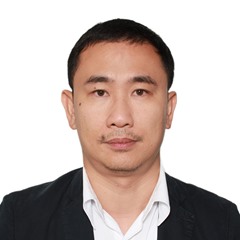A one-of-its-kind exhibition, 'Nuovo Paesaggio (New Landscape)' by internationally acclaimed Italian artist Quayola was unveiled at a VIP preview on Sunday at M7, offering a fresh exploration of natural landscapes through the lens of advanced technology and computational artistry.
The event was attended by the Italian Ministry of Foreign Affairs (MFA) secretary-general, ambassador Riccardo Guariglia; Italian ambassador to Qatar Paolo Toschi; and MFA’s Political Affairs’ deputy director Maurizio Greganti; National Museum of Qatar director HE Sheikh Abdulaziz bin Hamad al-Thani; and Qatar Museums CEO Mohammed Saad al-Rumaihi, among other guests.
Speaking to Gulf Times, curator Claudio Composti explained how Quayola bridges the gap between classical and contemporary art.
“Quayola’s work is very perfectly matched between classical and very contemporary because what we see here, it looks like a painting in this case for a photography but it is neither painting nor photography...”
He pointed out that Quayola’s artistic approach involves directly engaging with tradition and then subverting it through the application of advanced technologies.
New Landscape, promoted by the Italian embassy in Doha in collaboration with Fondazione AGO – Modena Fabbriche Culturali and with the support of the Directorate-General for Contemporary Creativity of the Italian Ministry of Culture, will be on view at M7 (first floor) until July 19.
The exhibition presents a unique blend of photographic techniques, emerging technologies, and computational strategies, challenging traditional representations of the natural world. It unfolds as an investigation into nature, observed and reinterpreted by machines, fostering a continuous dialogue between visual tradition and technological innovation.
About the tension between man-made algorithms and natural forms, Quayola cited the relationship between his work and nature, saying: “Everything we do is still connected to nature, it is in fact an inspiration that comes from nature. Even this ephemeral digital process is algorithmic techniques.
The artist utilises ultra-high-resolution cameras, 3D scanners, and laser sensors—such as Laser Imaging Detection and Ranging, or Lidar – to meticulously observe landscapes and natural phenomena, transforming them into complex digital renderings. In this process, organisers noted that the algorithmic gaze of the machine becomes a co-author, generating visions that reveal elements often invisible to the human eye, effectively introducing a new visual language.
New Landscape features two series: Storms and Remains: Vallée de Joux. Storms focuses on the coasts of Cornwall, capturing the chaotic behaviour of waves during storms and transforming atmospheric phenomena into visual matter.
Remains, on the other hand, explores the Swiss forests of the Vallée de Joux, offering an immersive journey where vegetation is scanned, interpreted, and rendered as an archetypal and dreamlike landscape.
In both series, organisers noted that natural elements such as waves, light, vegetation, and wind are converted into datasets, forming the foundation for an aesthetic construction where algorithmic intervention does not erase reality but redefines it.
In a press statement, Toschi, said: “This exhibition gives a new perspective to the dialogue between tradition and innovation on landscape, an artistic subject that both in Italy and in Qatar is at the centre of artistic and cultural experience”.

(From left) Paolo Tosch, Maurizio Greganti, Quayola, Mohammed Saad al-Rumaihi, and Sheikh Abdulaziz bin Hamad al-Thani at the VIP preview of "New Landscape" exhibition on Sunday. PICTURES: Thajudheen

Claudio Composti at the VIP preview.


